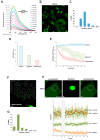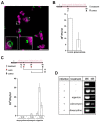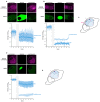Chlamydia Uses K+ Electrical Signalling to Orchestrate Host Sensing, Inter-Bacterial Communication and Differentiation
- PMID: 33467438
- PMCID: PMC7830353
- DOI: 10.3390/microorganisms9010173
Chlamydia Uses K+ Electrical Signalling to Orchestrate Host Sensing, Inter-Bacterial Communication and Differentiation
Abstract
Prokaryotic communities coordinate quorum behaviour in response to external stimuli to control fundamental processes including inter-bacterial communication. The obligate intracellular bacterial pathogen Chlamydia adopts two developmental forms, invasive elementary bodies (EBs) and replicative reticulate bodies (RBs), which reside within a specialised membrane-bound compartment within the host cell termed an inclusion. The mechanisms by which this bacterial community orchestrates different stages of development from within the inclusion in coordination with the host remain elusive. Both prokaryotic and eukaryotic kingdoms exploit ion-based electrical signalling for fast intercellular communication. Here we demonstrate that RBs specifically accumulate potassium (K+) ions, generating a gradient. Disruption of this gradient using ionophores or an ion-channel inhibitor stalls the Chlamydia lifecycle, inducing persistence. Using photobleaching approaches, we establish that the RB is the master regulator of this [K+] differential and observe a fast K+ exchange between RBs revealing a role for this ion in inter-bacterial communication. Finally, we demonstrate spatio-temporal regulation of bacterial membrane potential during RB to EB differentiation within the inclusion. Together, our data reveal that Chlamydia harnesses K+ to orchestrate host sensing, inter-bacteria communication and pathogen differentiation.
Keywords: Chlamydia; cell-to-cell communications and community; host-pathogen interactions.
Conflict of interest statement
The authors declare no conflict of interest.
Figures









Similar articles
-
Impact of Active Metabolism on Chlamydia trachomatis Elementary Body Transcript Profile and Infectivity.J Bacteriol. 2018 Jun 25;200(14):e00065-18. doi: 10.1128/JB.00065-18. Print 2018 Jul 15. J Bacteriol. 2018. PMID: 29735758 Free PMC article.
-
Single-Inclusion Kinetics of Chlamydia trachomatis Development.mSystems. 2020 Oct 13;5(5):e00689-20. doi: 10.1128/mSystems.00689-20. mSystems. 2020. PMID: 33051378 Free PMC article.
-
Computational Modeling of the Chlamydial Developmental Cycle Reveals a Potential Role for Asymmetric Division.mSystems. 2023 Apr 27;8(2):e0005323. doi: 10.1128/msystems.00053-23. Epub 2023 Mar 16. mSystems. 2023. PMID: 36927072 Free PMC article.
-
Type III Secretion in Chlamydia.Microbiol Mol Biol Rev. 2023 Sep 26;87(3):e0003423. doi: 10.1128/mmbr.00034-23. Epub 2023 Jun 26. Microbiol Mol Biol Rev. 2023. PMID: 37358451 Free PMC article. Review.
-
Host-pathogen reorganisation during host cell entry by Chlamydia trachomatis.Microbes Infect. 2015 Nov-Dec;17(11-12):727-31. doi: 10.1016/j.micinf.2015.08.004. Epub 2015 Aug 28. Microbes Infect. 2015. PMID: 26320027 Free PMC article. Review.
Cited by
-
Single Cell Cryo-Soft X-ray Tomography Shows That Each Chlamydia Trachomatis Inclusion Is a Unique Community of Bacteria.Life (Basel). 2021 Aug 18;11(8):842. doi: 10.3390/life11080842. Life (Basel). 2021. PMID: 34440586 Free PMC article.
-
Evidence supportive of a bacterial component in the etiology for Alzheimer's disease and for a temporal-spatial development of a pathogenic microbiome in the brain.Front Cell Infect Microbiol. 2023 Sep 13;13:1123228. doi: 10.3389/fcimb.2023.1123228. eCollection 2023. Front Cell Infect Microbiol. 2023. PMID: 37780846 Free PMC article.
References
-
- Eley A. Chlamydia trachomatis is bad for your sperm! Microbiol. Today. 2003;30:61–62.
-
- Skowasch D., Yeghiazaryan K., Schrempf S., Golubnitschaja O., Welsch U., Preusse C.J., A Likungu J., Welz A., Lüderitz B., Bauriedel G. Persistence of Chlamydia pneumoniae in degenerative aortic valve stenosis indicated by heat shock protein 60 homologues. J. Heart Valve Dis. 2003;12:68–75. - PubMed
Grants and funding
LinkOut - more resources
Full Text Sources
Other Literature Sources
Molecular Biology Databases

